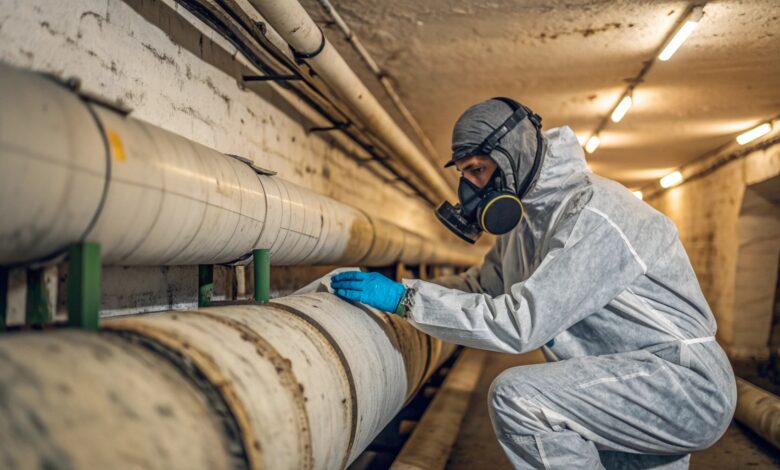Asbestlint: Hidden Dangers of Old Building Materials

Asbestlint: Hidden Dangers of Old Building Materials – Learn what asbestlint is, where it’s found, and why it poses health risks to homeowners and workers. Understand how to identify, test, and safely remove asbestos-based lint from older buildings. Get detailed insights into U.S. safety regulations, prevention strategies, and modern asbestos-free alternatives. This guide helps you protect your home, family, and workplace. Stay informed and act responsibly to avoid asbestos exposure.
Stay tuned with us we will talk about Asbestlint: Hidden Dangers of Old Building Materials.
What Is Asbestlint?
Asbestlint refers to fibrous, threadlike dust or tape-like material derived from asbestos-containing products. It often forms when old insulation, gaskets, or wraps degrade over time, releasing fine, airborne particles that are easily inhaled. These fibers are invisible to the naked eye and can linger in the air for hours, making them one of the most hazardous forms of asbestos exposure.
Asbestos itself was once praised for its fire resistance and insulation properties, leading to widespread use throughout the 20th century. However, when these materials break down, they shed asbestlint — tiny strands that pose long-term health threats if inhaled or ingested.
Common Sources and Locations of Asbestlint
Asbestlint can appear in various environments, especially in older structures built before asbestos regulations tightened. Below are the most common places it can be found:
- Pipe insulation and heating ducts in pre-1980 buildings
- Boiler rooms and furnace insulation
- Vinyl floor tiles and adhesives
- Ceiling tiles, textured coatings, and drywall compounds
- Fire-resistant tapes, ropes, and gaskets
- Automotive brake linings and clutches in vintage vehicles
Industrial and Commercial Sites
Factories, schools, power plants, and shipyards built during the mid-1900s often used asbestos tape or wraps around high-temperature equipment. Over time, as these materials aged or were disturbed, they released asbestlint into the air and surrounding surfaces.
Health Risks and Medical Concerns
Exposure to asbestlint can lead to several serious health conditions, many of which appear years or decades after initial contact. The risk depends on duration, intensity, and the type of asbestos fiber inhaled.
Major Diseases Linked to Asbestlint
- Asbestosis: Scarring of lung tissue, leading to chronic shortness of breath.
- Mesothelioma: A rare, aggressive cancer that develops in the lining of the lungs or abdomen.
- Lung Cancer: Increased risk, especially in smokers exposed to asbestos fibers.
- Pleural Plaques: Thickened areas on the lung lining, which may impair breathing.
Latency Period and Cumulative Risk
Asbestlint exposure doesn’t cause immediate illness. Symptoms can take 20–50 years to appear, making early detection and prevention crucial. Even minimal exposure can accumulate over time, so there’s no truly safe level of asbestos contact.
How to Identify Potential Asbestlint
Identifying asbestlint requires both visual inspection and laboratory testing. While the fibers themselves are microscopic, certain indicators can suggest asbestos presence.
Visual Indicators
- Frayed insulation tape or cloth around pipes and joints
- Dusty or fibrous residue near heating or ventilation systems
- Old, deteriorating ceiling or floor tiles
- Grayish or white lint-like material in mechanical rooms
Testing Methods
- Bulk Sampling: Professionals collect a small piece of material for lab analysis.
- Air Sampling: Measures the number of airborne fibers using specialized pumps and filters.
- Microscopy Analysis: Techniques like polarized light microscopy (PLM) and transmission electron microscopy (TEM) confirm asbestos presence.
Never attempt DIY testing — disturbing materials increases airborne fiber release and risk of inhalation.
Safe Handling and Removal Procedures
If you suspect asbestlint in your property, immediate caution is essential. The safest action is to avoid disturbing the area and contact certified asbestos abatement professionals.
Safety Preparations
- Isolate the affected zone and restrict entry.
- Turn off HVAC systems to prevent fiber spread.
- Post warning signs in visible areas.
Protective Equipment
Professionals use:
- HEPA-filtered respirators
- Disposable coveralls and gloves
- Eye protection and shoe covers
Removal Steps
- Wet the material with a fine mist to reduce dust.
- Carefully remove insulation or tape in sealed sections.
- Double-bag all waste in labeled asbestos containers.
- Decontaminate tools and surfaces with HEPA vacuums.
- Dispose of waste only at approved hazardous waste facilities.
Improper removal can result in serious health risks and legal penalties.
Legal Regulations and U.S. Compliance Standards
The U.S. has strict regulations on asbestos management and disposal to safeguard public health.
- EPA (Environmental Protection Agency): Oversees the Asbestos Hazard Emergency Response Act (AHERA) and Clean Air Act.
- OSHA (Occupational Safety and Health Administration): Sets exposure limits for workers and mandates protective equipment.
- State Regulations: Each state may require its own certification, reporting, and disposal procedures.
Property owners must inspect for asbestos before renovation or demolition. Violating asbestos laws can lead to heavy fines or criminal liability.
Modern Alternatives to Asbestlint Materials
Today, numerous safer materials have replaced asbestos in insulation, sealing, and fireproofing applications.
| Replacement Material | Benefits | Common Uses |
| Fiberglass Tape | Fire-resistant, durable, asbestos-free | Pipe insulation, sealing joints |
| Mineral Wool | Excellent heat and sound insulation | Wall and ceiling insulation |
| Ceramic Fiber Cloth | Withstands high heat, non-toxic | Industrial and automotive insulation |
| Silicone Tape | Flexible, waterproof, safe | HVAC and plumbing applications |
| Cellulose Insulation | Eco-friendly, renewable | Residential insulation |
Choosing modern materials eliminates long-term health risks and ensures compliance with safety regulations.
Prevention and Risk Management Strategies
Proactive management is the best way to prevent asbestos exposure.
For Homeowners
- Have older homes inspected by certified asbestos professionals.
- Avoid DIY renovations in areas with old insulation or ceiling materials.
- Maintain ventilation and minimize dust disturbance.
For Building Managers
- Create an asbestos management plan.
- Keep detailed records of inspections and abatement activities.
- Train maintenance staff in asbestos awareness and safe work practices.
Regular monitoring ensures continued safety and compliance with legal standards.
Common Myths About Asbestlint
Misinformation can make asbestos exposure more dangerous. Here are some misconceptions:
| Myth | Reality |
| “If it’s not crumbling, it’s safe.” | Even intact asbestos can release fibers when disturbed. |
| “A dust mask offers protection.” | Only HEPA-rated respirators prevent inhalation of microscopic fibers. |
| “Short exposure won’t cause harm.” | Health effects can develop from minimal contact over time. |
| “Asbestos is banned everywhere.” | Some products still legally contain trace asbestos in the U.S. |
| “DIY removal saves money.” | Unlicensed handling risks health and legal consequences. |
Understanding the facts helps homeowners and professionals make safe, informed choices.
When to Call a Professional
Call a licensed asbestos inspector or abatement contractor if you:
- Plan to renovate or demolish an older property.
- Notice fraying insulation or dust around mechanical systems.
- Are unsure whether certain materials contain asbestos.
Professionals use controlled procedures to test, seal, and remove hazardous materials without exposing occupants. Always verify that the contractor holds valid certification and follows EPA and OSHA protocols.
Conclusion
Asbestlint represents one of the most overlooked asbestos hazards in older homes and industrial sites. It forms when insulation, tapes, or wraps deteriorate, releasing fine fibers that remain airborne and easily inhaled. Exposure can lead to severe diseases such as mesothelioma, asbestosis, and lung cancer, often decades after initial contact. Identifying, testing, and managing asbestlint requires professional expertise and strict adherence to safety procedures.
Modern alternatives like fiberglass, mineral wool, and silicone tape now offer safe, effective replacements. Compliance with EPA and OSHA regulations ensures that abatement projects protect both workers and residents. Preventive measures such as regular inspections, record keeping, and asbestos awareness training further minimize risks.
By understanding the nature of asbestlint, property owners can make informed decisions, protect their health, and preserve building safety. Awareness, proper handling, and proactive management are the keys to a safer, asbestos-free future.
FAQs
What is asbestlint?
Asbestlint is a fibrous dust or tape-like residue produced when asbestos materials degrade or are disturbed in older structures.
Where is asbestlint commonly found?
It’s found in insulation wraps, pipes, ceilings, flooring, and heating systems built before 1980.
Can I test for asbestlint myself?
No, testing should only be done by certified professionals to avoid exposure during sampling.
Is all insulation from old homes dangerous?
Not all insulation contains asbestos, but any material installed before the 1980s should be professionally assessed.
How can I safely replace asbestos materials?
Hire licensed abatement contractors to remove them and replace them with modern, asbestos-free alternatives like fiberglass or mineral wool.



